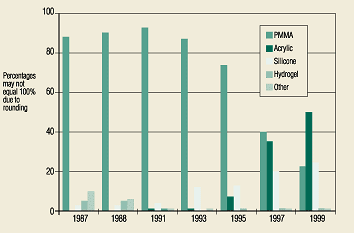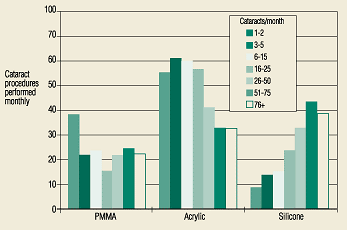Acrylic, silicone lenses see upswing
Both materials are preferred to PMMA, but high-volume surgeons say they still need all three materials.
Acrylic and silicone IOLs have become the preferred materials over PMMA, but high-volume surgeons say they still use PMMA lenses for a variety of reasons.
According to the Leaming survey presented at the American Society of Cataract and Refractive Surgery meeting, PMMA lenses were preferred by 40% of surgeons in 1997, with acrylic lenses just behind at 38% and silicone lenses at 20%. By 1999, the Leaming survey showed that PMMA lenses were preferred by only 23% of surgeons, while acrylics had risen to 49% and silicone lenses were preferred by 26%.
“PMMA dropped exponentially between 1995 and 1999,” said David V. Leaming, MD. “Acrylic took off when it became available.”
High-volume surgeons
OPTIC MATERIAL PREFERENCE (1987-1999) |
 |
However, the high-volume surgeons do not prefer acrylic lenses as often as silicone, Dr. Leaming said.
Surgeons performing between one and 25 cataracts per month use acrylic lenses for 60% of procedures. But surgeons who do between 26 and 75 cataracts per month use acrylic lenses for 41% of procedures. Those who do more than 76 cataract procedures per month use acrylic lenses in 32% of procedures, Dr. Leaming said.
“It’s interesting that the high-volume surgeons still prefer silicone over acrylic,” Dr. Leaming said. “It may have to do with the fact that they’ve been using it for so long that they are very comfortable with the material. For the lower volume surgeons, ones that may just be getting into foldables, it may be easier for them to use the acrylic material with its characteristics and properties.”
Some surgeons may prefer acrylic lenses because they unfold more slowly, Dr. Leaming said. But those with more experience may prefer silicone lenses because they unfold rapidly.
According to Steven B. Siepser, MD, when lenses unfold slowly, it takes time to assess the patient’s postoperative vision. His goal is to complete the surgery, sit the patient upright and immediately ask them to read a clock on the far side of the operating room. That way, problems can be corrected while the patient is still on the operating table.
When lenses unfold slowly, “You really can’t be sure of stabilization of the lens for probably at least 30 seconds to a minute because it’s still bent and you’re not sure where the haptics are.”
OPTIC MATERIAL PREFERENCE vs. VOLUME (1999) |
 |
He does up to 30 cases daily, and the extra time needed for the lens to unfold breaks his rhythm and consumes about a half hour each day, he said.
Also, he makes a wide capsulorrhexis, and displacing even one lens per month would cause problems. With the more rapidly expanding silicone, he said, “It’s set on the table. You’re done. Everything is right. You’ve checked the astigmatism. You’ve got the implant where it belongs. In 3 seconds you know that it was a good operation.”
PMMA finds role
Despite the trend toward new IOL materials, Dr. Leaming said he still prefers PMMA lenses. When he uses foldable lenses, he prefers acrylics. Dr. Siepser added that he too uses PMMA lenses, in addition to acrylics and silicones.
At high powers of correction, he chooses to open the wound to 5 mm and implant a PMMA lens to avoid having to insert a “bullet of silicone” through the wound. And at low powers of correction, he avoids acrylic or silicone lenses and implants a 13.5-mm diameter lens with a 6-mm optic because of the size of the eye.
“I don’t have a lens of choice; I have a lens that’s appropriate for the patient,” Dr. Siepser said. “The patient’s needs choose the implant.”
For Your Information:
- David V. Leaming, MD, can be reached at 1100 N. Palm Canyon Drive, Ste. 112, Palm Springs, CA 92262; (760) 320-7051; fax: (760) 320-7683.
- Steven B. Siepser, MD, can be reached at 91 Chestnut Road, Paoli, PA 19301; (610) 296-3333; fax: (610) 296-3030; e-mail: SSIEPSER@clear-sight.com.
